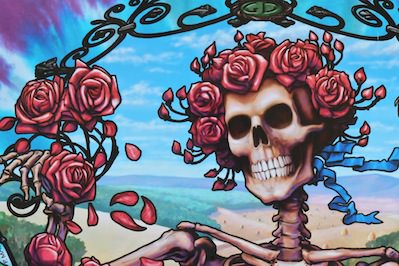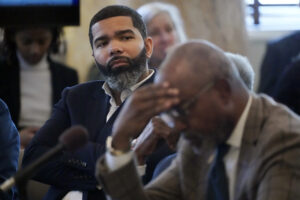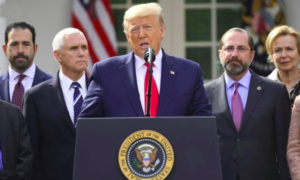No Simple Highway
This excerpt, recounting the media reaction to the death of Jerry Garcia, is from Truthdig contributor Peter Richardson’s critically acclaimed new book, "No Simple Highway: A Cultural History of the Grateful Dead." Photo by Hypnotica Studios Infinite (CC BY 2.0)
Photo by Hypnotica Studios Infinite (CC BY 2.0)
Photo by Hypnotica Studios Infinite (CC BY 2.0)
The following excerpt is from Truthdig contributor Peter Richardson’s critically acclaimed new book, “No Simple Highway: A Cultural History of the Grateful Dead.” In this section, Richardson recounts the media reaction to the death of Jerry Garcia, the Grateful Dead’s lead guitarist. Reprinted by permission. All rights reserved.
On the morning of August 9, 1995, Paul Liberatore of the Marin Independent-Journal was showering when his wife told him he should get to work: Jerry Garcia was dead. It wasn’t the first time Liberatore had heard such a report, but this one was authentic. A counselor at a Marin County drug rehabilitation facility had checked Garcia’s bedroom early that morning because he could no longer hear Garcia’s loud snoring. The counselor found Garcia dead with a smile on his face. As that news spread, Liberatore worked overtime. “I reported my ass off for a week,” he said. The Gannett news group owned the Marin County newspaper, and because management wanted to attract younger readers, editors had discouraged stories about the Dead. Liberatore tried to reason with them, but at one point, an editor threw Garcia’s photograph on the floor, saying he wouldn’t run it. Liberatore’s instincts were confirmed when Garcia’s death produced the best-selling issue in the newspaper’s history. “The numbers were off the charts for days,” he said.
Garcia’s life, music, and death quickly dominated other Bay Area media outlets. The San Francisco Examiner ran three Garcia stories on the front page, three more on the front page of the style section, and two more on the front page of the business section. An editorial in the San Francisco Chronicle titled “American Beauty” noted that the one adjective that ran consistently through commentaries on Garcia’s life was integrity. “In a popular culture that sacrifices every value to mercenary pursuit,” it continued, “Garcia never lost the romantic ideals of San Francisco in the 1960s, the special era that spawned his music and nurtured it into the 1990s.”
San Francisco Mayor Frank Jordan ordered the city’s flags to be flown at half-mast, and heartfelt eulogies appeared from the expected sources. Ken Kesey called Garcia “a great warrior, battling for hearts and souls way out on the dangerous frontier.” Bob Dylan also praised Garcia and lamented the loss. “To me he wasn’t only a musician and a friend, he was more like my big brother who taught and showed me more than he’ll ever know,” Dylan said. “There are a lot of spaces between the Carter Family, Buddy Holly, and, say, Ornette Coleman, a lot of universes, but he filled them all without being a member of any school. His playing was moody, awesome, sophisticated, hypnotic, and subtle. There’s no way to convey the loss. It just digs down really deep.” Departing Garcia’s funeral, Dylan reportedly told music promoter John Scher, “That man back there is the only one who knows what it’s like to be me.”
In the national media, Vermont senator Patrick Leahy, a longtime Dead fan, said the news made him feel as if he had been kicked in the stomach. Wearing a black ribbon on his lapel, Governor William Weld of Massachusetts called a news conference to express his grief. He told reporters that he discovered the Dead in the 1960s and listened to Workingman’s Dead and American Beauty the previous night. Only protests from veterans groups persuaded him not to fly the state’s flags at half-mast. A lengthy New York Times obituary quoted Stewart Brand, who had hosted the Trips Festival in 1966 and published the Whole Earth Catalog: “Some of the things the hippies got right came out the strongest and clearest in the Grateful Dead.” Rolling Stone, Entertainment Weekly, Newsweek, and People quickly produced cover articles or special issues. People also followed up with a major story on Garcia’s funeral and public memorial in Golden Gate Park, where 25,000 fans gathered.
Even the tabloids tried to capitalize on Garcia’s demise. The Globe reported sloppily that Garcia and his wife, who had been married less than two years, “went through a lot together before he finally died after a lifetime of drug and alcohol abuse.” Garcia’s death also revived media stereotypes about the Dead Head community. When writer and Dead aficionado Steve Silberman appeared on CNN, he was asked if he “dressed like a Dead Head.” “Yes,” Silberman replied. “I wear whatever I want.” The following week, the Marin County coroner concluded that Garcia had used heroin within days of his death, but that the drug didn’t contribute to the heart attack that killed him. Instead, 85 percent blockage in two of the arteries leading to his heart reduced blood flow to a pinpoint. That finding didn’t prevent many pundits from moralizing about drugs, and for some of them, Garcia’s death also became a referendum on the 1960s. “The band has prospered as the emblem of an era and is complicit in the continuing consequences of the era,” George Will wrote in Newsweek. “Around it has hung an aroma of disdain for inhibitions on recreational uses of drugs and sex. During the band’s nearly 30-year life the costs of ‘liberation’ from such inhibitions have been made manifest in millions of shattered lives and miles of devastated cities.” There’s a dark irony in Will’s charge. In 2003, he became a full-throated supporter of the U.S. invasion of Iraq, which actually did shatter millions of lives and devastate cities. After most of the damage was done, he blamed the disaster on Vice President Dick Cheney. Almost a decade later, Will wrote a series of columns that seemed to endorse the legalization of drugs, a position Garcia had held for years.
At least Will was corrigible. His former employer at National Review, William F. Buckley, also seized on Garcia’s death to scold the counterculture, and his brief was even thinner than Will’s. In his National Review column, Buckley recalled an intern at his magazine who attended a Grateful Dead show and enjoyed it. The intern’s work began to drop off, and he later moved to South America to teach English. “Jerry Garcia didn’t help this young man,” Buckley wrote. “We did not hear again from him, except after an interval of five years or so, when we learned he had married again, this time a native, and gone off to live in the hills. Question before the house: Is Jerry Garcia in some way responsible for this?” According to Buckley, the answer was yes. He asserted that Garcia had “killed, if that’s the right word for such as our intern, a lot of people.”
Buckley’s claim was absurd, even obscene, especially coming from a stout defender of America’s bloody intervention in Vietnam. It makes sense only as a symptom of the ideological contest over the nature and meaning of the 1960s. But it wasn’t clear that Buckley’s view would prevail even at his own magazine. Deroy Murdock, a Dead Head who also wrote for National Review Online, held a less negative view of Garcia. “Jerry Garcia’s abuse of his bear-like body should teach all of us a lesson on the value of moderation,” he wrote. “But the rest of his life—from the music to which he remained true for over 30 years to the spirit of freedom that still permeates the community he led—amiably embodied an all-American ideal: the pursuit of happiness.” Murdock’s conclusion was also consistent with Garcia’s statements. “We’re basically Americans, and we like America,” Garcia said. “We like the things about being able to express outrageous amounts of freedom.” In this sense, and despite the flak they took from conservatives, the Dead were as American as apple pie—or a lynch mob, as Garcia once remarked pointedly.
Syndicated columnist Mike Barnicle also weighed in against Garcia. “Look,” Barnicle wrote, “Jerry Garcia seemed like a nice fellow, and it’s unfortunate he died at age 53 because apparently he made some smile and tap their toes, and that’s better than a thumb in the eye.” But any reverence for Garcia flipped Barnicle’s sarcasm switch. “Poor Jerry. Boy, could he play the guitar. And what a fabulous outlook he had on life. Jerry was against the war and for civil rights. Jerry was good. He smiled all the time. No kidding—Jerry was smacked out of his mind.” Three years later, Barnicle left the Boston Globe amid charges that he had fabricated a story about cancer patients and recycled comedian George Carlin’s observations without attribution. As the Globe considered Barnicle’s future with the newspaper, he received little support from his colleagues, fifty of whom signed a petition calling for tougher treatment after the Carlin incident.
Even President Clinton commented on Garcia’s death. “Well, first of all, he was just a great talent,” Clinton said in an MTV interview. “I mean, he was really—he was a genius, and I was really pleased to see the Grateful Dead have one more great run around the country, you know, in the last couple of years and see all these young teenagers gravitating to a group that all of us liked 20 or more years ago.” Clinton claimed that he enjoyed wearing and giving away neckties based on Garcia’s paintings, but he added that he “would hope that as we mourn him and sort of feel grateful for what he did, young people should say, ‘I’m not going to die that way. I’m not going to die in a clinic with a drug addiction.’”
Clinton’s DEA chief, Thomas Constantine, saw less need to temper his views. He claimed that the nation could never hope to defeat the scourge of drugs if Americans eulogized Garcia. “And you can’t have Jerry Garcia, reportedly a heroin addict, now being extolled as one of the great parts of the American system, and what a wonderful person he was, and things like that,” he said. In his remarks that day, Constantine added that he was uncomfortable with the term “war on drugs.” In fact, he said, “there has never really been a war on drugs because the American public has never made a commitment to invest the resources that would be required for the struggle.” That year, the federal government spent more than $13 billion on drug policy and enforcement—roughly equivalent to $20.4 billion in 2014 dollars.
Your support matters…Independent journalism is under threat and overshadowed by heavily funded mainstream media.
You can help level the playing field. Become a member.
Your tax-deductible contribution keeps us digging beneath the headlines to give you thought-provoking, investigative reporting and analysis that unearths what's really happening- without compromise.
Give today to support our courageous, independent journalists.






You need to be a supporter to comment.
There are currently no responses to this article.
Be the first to respond.